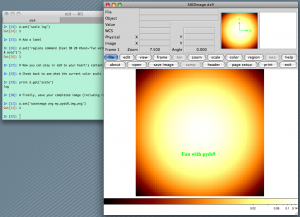

Links to an image of each spectrum and the corresponding best-fit MeKaL model (solid-line) are provided below the image. To remove the effects of vignetting and exposure time fluctuations we corrected each surface brightness profile by an observation specific normalized radial exposure profile.Īnnuli used for generating temperature profileĮach annulus is centered at RA: 00:43:24.881, Decl: -20:37:25.08 and contains 2500 counts. We began by extracting surface brightness profiles from the 0.7-2.0 keV energy range using concentric annular bins of size 5" (~10 ACIS pixels) originating from the X-ray center. Periods with count rates >= 3sigma and/or a factor >= 1.2 of the mean background level of the observation were removed from the GTI file. To check for contamination from background flares or periods of excessively high background, light curve analysis was performed using Maxim Markevitch's contributed CIAO script lc_clean.sl. Image taken from Digitized Sky Survey (DSS) The SDSS/DSS footprint (white box) is centered on the cluster core.ĭigitized Sky Survey (DSS) image of cluster core SDSS/DSS footprint overlaid on cluster core Same as the wide-field image above but the binning factor used here was 2. Smoothed and binned Chandra X-ray image of the cluster "core" Point sources have not been excluded and no exposure correction has been applied to this image. Smoothed and binnd wide-field Chandra X-ray image of clusterĪ gaussian smoothing kernel with size 2 was applied to the flare-cleaned, level-2 events file binned with a factor of 8 to produce this image.
#SAOIMAGE DS9 GAUSSIAN DOWNLOAD#
(10) bolometric luminosity ExpĬlick here to download a master table of profiles for this cluster.Īll images generated using SAOImage DS9, developed by the Smithsonian Astrophysical Observatory.

(9) average cluster metal abundance and col. (7) minimum counts used per T X annulus col. (6) maximum radius from cluster center, R max col. (4) Galactic absorbing column density, N H col. (2) right ascension of cluster center col.


 0 kommentar(er)
0 kommentar(er)
